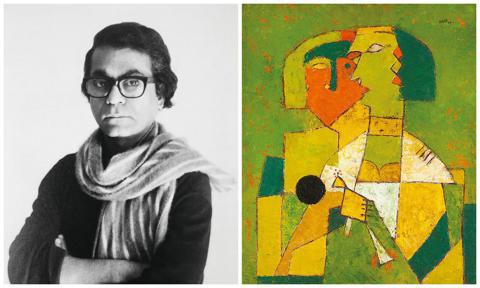
Invited by MF Husain, SH Raza, and FN Souza into the select group of Indian Progressives, Vasudeo Gaitonde was a Maharashtrian artist who was celebrated more by the West than he was ever in India. Winner of The Young Artists Award in Tokyo in 1957 and the Rockefeller Artist Fellowship in 1964, Gaitonde exhibited his works around the world, including at the MoMA in New York, but died in obscurity in 2001, having spent his last days in New Delhi. In December 2013, Christie’s held their very first auction in India, selling a jewel- toned Gaitonde to an anonymous American buyer for US$3.7 million. At the time, this was the highest ever paid for a work by an Indian Progressive, beating even the record achieved by Raza’s ‘Saurashtra’ and cementing Gaitonde’s place among the country’s top artists. Sandhini Poddar, a scholar who curated the Gaitonde exhibit at the Guggenheim in New York, chronicled the artist’s life, delving into his work like no other Indian scholar ever had.
“Apart from looking to Western artists as kindred spirits, Gaitonde also drew strength from India’s schools of miniature painting as well as Zen Buddhism, as epitomised in medieval Japan,” explains Poddar. “This charts the life of Vasudeo S Gaitonde and his practice from 1952 until 1998, the year the artist painted his final canvas.”
Explaining the reason why she was first inspired by the mesmerising works of Gaitonde, Poddar says, “I was inspired to learn more about the artist when I encountered a suite of canvases at the National Gallery of Modern Art in Mumbai, when they showed aspects of Jehangir Nicholson’s private collection. These paintings had a profound impact on me, so I proposed the retrospective to the Guggenheim’s curatorial team several years ago.”
While many view his works with a sense of awe, understanding the subject is an uphill task for laymen. “Gaitonde always preferred to call his work ‘non-objective’ rather than ‘abstract.’ One can see him drawing inspiration from nature, music and abstraction in ways similar to early pioneers like Kandinsky, Mondrian and Klee.”
Then there was the issue of finding works by Gaitonde since the artist only painted five to six canvasses a year. “It took us over a year and a half to source the 45 works that were finally selected for the exhibition checklist. Locating these drawings and paintings, which are dispersed in public and private collections all over the world, was a challenging task. Even months before the exhibition was due to premiere in New York, I continued to get to know of existing works I hadn’t ever seen before.”
“Gaitonde’s work has never been documented before now, so my essay in the catalogue as well as many of the images we used were all produced from scratch. Apart from the lack of credible information, several works had also suffered physically over a long period of time, so we had to be very careful in our selection process. It’s been a daunting but exciting challenge.”
Gaitonde used different techniques while creating his works, to give them a weightless feel. How he achieved this effect has been a topic of discussion among many art critics.
“It’s true that several of his works, especially his paintings, have a sense of weightlessness. But this immateriality (and ensuing lyricism) is counterbalanced by a physicality, achieved through layers of paint and his use of vivid colours. These works would hold their own in any space.”

“Gaitonde’s technique changed over the years, starting in the late 1950s. While he used rollers and palette knives initially, his later paintings, starting in the early 1970s, consist of beautiful silhouettes and floating abstract shapes created by a special ‘lift-off’ technique he developed using newspaper and magazine scraps.”
“He was one of the few Indian artists who remained committed to non-objective or non- representational art throughout the period of his mature output. So the choices he made in terms of form, colour, texture and atmosphere were very particular to this artistic worldview.”
As with most artists, Gaitonde, too, only got his dues and proper acknowledgment of his talent after his death.
“His work was always supported by a small coterie of collectors and well-wishers within his lifetime. However, his death in 2001 coincided with the opening up of the South Asian market to global forces, and we have continued since then to encounter a sharp escalation in his auction prices. There are a handful of writers, gallerists, and historians today who are working on various publications on the artist now.”
“A large part of his obscurity as an artist (outside of the immediate South Asian community in India and within the diaspora) is due to the reasons I already mentioned. Gaitonde, it seems, was also disinterested beyond a point in participating in the commercial side of the art world. Instead, he was focused on his immediate creative process and to enjoying the worlds of theatre, cinema, music and literature.”
In the case of many famous artists, it’s their families that keep the legacy of the genius alive after their deaths.
“Gaitonde’s sister, Kishori Das, continues to live in Mumbai, but I have not dealt with her in the retrospective,” shares Poddar. “He cut his ties to his immediate family early on, but had life-long affiliations that he maintained. I’ve reached out to several of these artists, gallerists, historians, and friends who knew Gaitonde well and have relied on their anecdotes and past relationships to try and knit his story together. I hope it will inspire other scholars and authors to take up the baton and pursue further research.”
This story has been adapted for the website from a story that was originally published in HELLO! India’s June 2022 issue. Get your hands on the latest issue right here!






